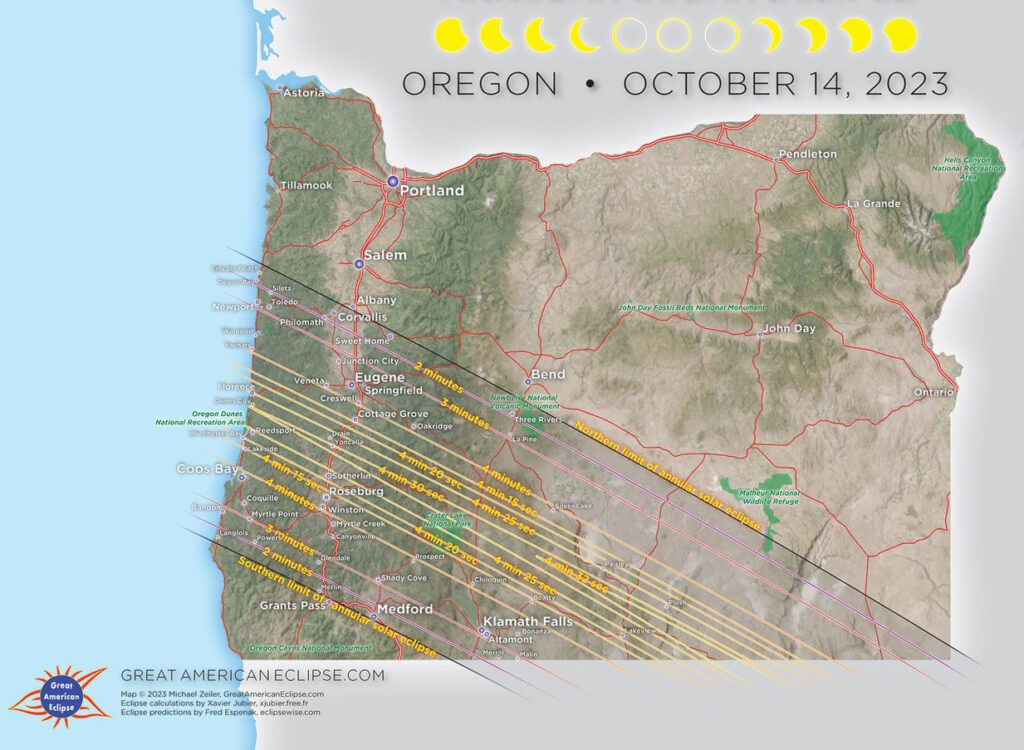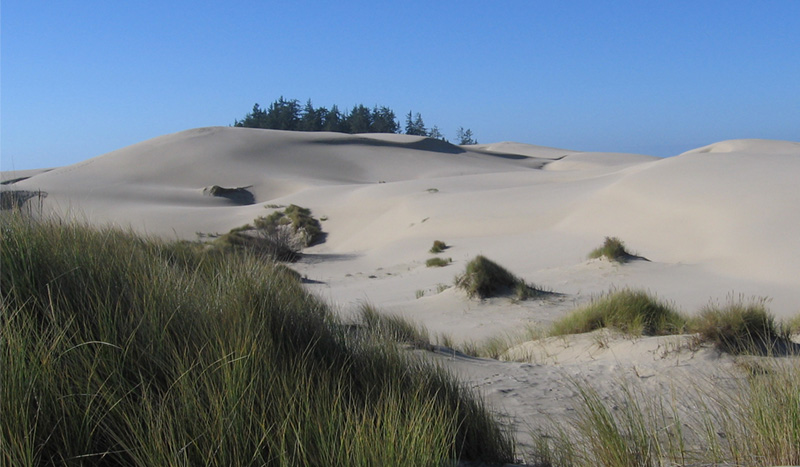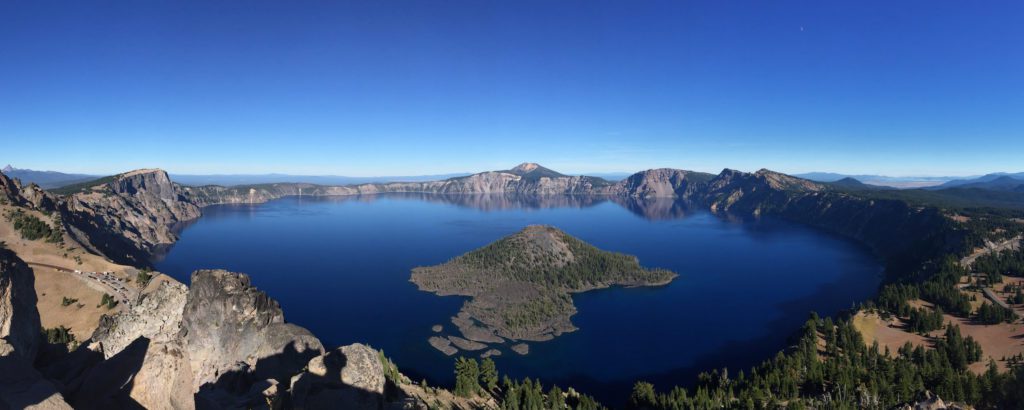
An “annular eclipse” happens when the moon is too far away to block out the sun completely, leaving a ring of light around its edges. Next one visible in Oregon will be Oct 14, 2023 at around 9:15 am. Because the sun won’t be completely blocked out, viewers won’t see the sun’s corona – the main attraction of a total solar eclipse. However, people may be able to see a phenomenon known as “Baily’s beads,” where the sunlight seems to bead as it comes through the rugged surface of the moon. Unlike a total eclipse, specialized eclipse glasses are needed the entire time to protect your eyes. You can catch a glimpse at many places on the coast and further west.

Oregon Dunes National Recreation Area
The first landfall of the annular solar eclipse on October 14, 2023 will be at Oregon Dunes National Recreation Area. The Oregon Dunes National Recreation Area is located on the Oregon Coast, stretching approximately 40 miles north of the Coos River in North Bend to the Siuslaw River in Florence, and adjoining Honeyman State Park on the west.
The Dunes are the product of millions of years of erosion by wind and rain on the Oregon Coast. There are about 7,000 acres (28 km2) of sand dunes. The Oregon Dunes National Recreation Area provides numerous recreational activities, including off-highway vehicle (OHV) use, hiking, fishing, canoeing, horseback riding, and camping.
Near Coos Bay, Bullards Beach is a large, family-oriented park located at the mouth of the Coquille River, two miles north of Bandon. Coquille River Lighthouse is located at the end of Bullards Beach Road. And where the Coquille River meets the Pacific Ocean, the nutrient-rich waters slowly ebb and flow over the mudflats, salt marshes, and forested wetlands at Bandon Marsh National Wildlife Refuge. Perhaps viewing the eclipse from the Coquille River! Visitors may explore the Refuge by boat at some tides, especially the Fahy Creek area which offers wildlife viewing and fishing opportunities. Visitors can launch a small boat, canoe, kayak, paddleboard or other nonmotorized craft at Rocky Point Count Park or Bullard’s Beach State Park.
While Oregon is the first US state to see the “ring of fire” perhaps avoiding its coast, which can often be covered in mist and cloud and go inland, where, the chances of a clear sky increase. Cities inside the eclipse’s path are Corvallis, Eugene, Roseburg, Coos Bay, Medford, and Klamath Falls.
A popular destination in Oregon will be Crater Lake National Park. What better spot to see the circle of fire both in the sky and reflected in the pristine waters.

Crater Lake National Park, the tranquil gem of the Cascade Range, is set in a dormant volcano called Mount Mazama, one in the chain of volcanoes that includes Mount St. Helens. Native Americans witnessed its formation 7,700 years ago, when a violent eruption triggered the collapse of a tall peak. It’s the deepest lake in the USA and one of the most pristine on Earth. 21 square-miles of water so intensely blue, ringed by cliffs towering up to 2,000 feet above. The mountain bluebird, Native American legend says, was gray before dipping into these waters.
In Klamath County, below Crater Lake National Park, the EclipseFest 2023 event will include camping, RVs, food, live music from Smash Mouth—and a “ring of fire” at 9:17 a.m. PDT for 4 minutes 22 seconds.
After the fleeting glimpse of the moon and sun, you may be tempted to explore the park’s 183,224 acres and the surrounding area in Klamath Falls. Early Fall is a great time to visit the park. This time of year, the weather is mild, the skies are sunny, and the roads are clear. Even though Crater Lake is open year-round, many of the access roads close as early as October due to snow and remain closed through Spring. Nearby campgrounds for reservation include Lost Creek campground, Farewell Bend campground, and Union Creek campground, all of which are managed by Umpqua National Forest and can be reserved on recreation.gov.
Klamath Falls, Oregon
Nearby you find Fort Klamath, in an old military outpost near the western end of the Oregon Trail between Crater Lake National Park and Upper Klamath Lake, Fort Klamath now serves as the Klamath County Museum. Set on 8 acres, the museum’s grounds include the graves of four members of the Modoc tribe, including Captain Jack, executed by the U.S. Army after the Modoc War of 1872-73. Aside from its rich history, Fort Klamath is known for its location along the Volcanic Legacy Scenic Byway, proximity to Crater Lake National Park, and the epic fly fishing, birding, and kayaking on the nearby Wood River.
The Three Sisters Wilderness Area , west of Bend, is a scenic area just inside the northern limit of annular solar eclipse, a great location for eclipse chasers seeking an extended view of Baily’s Beads. The Three Sisters Wilderness area covers 281,190 total acres. There are approximately 260 miles of trail within the wilderness. The Pacific Crest National Scenic Trail traverses the wilderness for 40 miles. Major peaks are: the North, Middle, and South Sisters (all above 10,000′), along with Broken Top, the best example in the Pacific Northwest of the effect of glaciation. Collier Glacier is the largest glacier in Oregon. Other geologic features include Rock Mesa, Collier Cone, and Yapoah Crater. After the sun returns, head out here to explore alpine meadows, waterfalls, lava fields, glaciers, and glacial lakes. NWFP is good here.
Prepare for your 2023 adventure: eclipse protective glasses, America the Beautiful National Park Pass, Northwest Forest Pass, and souvenirs can be found in our shop.
This eclipse will be a warm-up act for the spectacle of the total solar eclipse crossing the United States, only 177 days to go on April 8, 2024. While not as dramatic as a total solar eclipse, an annular solar eclipse promises a spectacular vision featuring the striking sight of the Sun as a ring. And our national parks and preserv,es.
Eclipse Map and timeline found here: www.greatamericaneclipse.com/oregon-2023-eclipse
